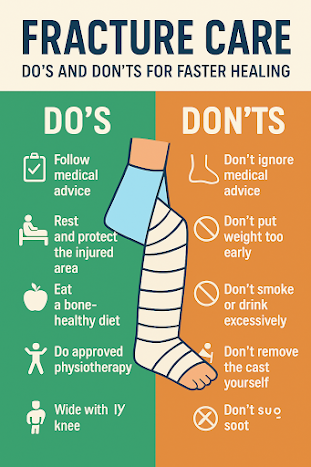Fractures are among the most common injuries, affecting people of all ages. Whether it’s a broken arm from a fall, a fractured ankle during sports, or a hip fracture in older adults, proper care is essential for fast and smooth healing. Many people assume that once a cast or splint is applied, recovery is automatic. But the truth is, how you care for your fracture during the healing period makes a huge difference in recovery speed, bone strength, and long-term mobility.
What is a Fracture?
A fracture is a medical term for a broken bone. It can occur due to trauma (accidents, falls, sports injuries), repeated stress on a bone, or bone-weakening conditions like osteoporosis.
What are the Types of Fractures:
- Simple (Closed) Fracture – Bone breaks but does not pierce the skin.
- Compound (Open) Fracture – Bone breaks and punctures the skin, risk of infection is higher.
- Greenstick Fracture – Common in children, bone bends and cracks but doesn’t break completely.
- Comminuted Fracture – Bone shatters into multiple pieces.
- Stress Fracture – Tiny cracks in the bone, often from repetitive motion (athletes).
- Pathological Fracture – Breaks due to diseases like osteoporosis, cancer, or infections.
How Do Fractures Heal?
Bone healing is a natural process, but it takes time. The body goes through stages:
- Inflammatory Stage (First Few Days)
- Blood clots form at the fracture site.
- Swelling and pain occur as the body responds to injury.
- Reparative Stage (2–6 Weeks)
- A soft callus made of collagen forms around the break.
- Slowly replaced by hard bone tissue.
- Remodeling Stage (Several Months)
- Bone reshapes itself, regaining strength and normal function.
Do’s for Faster Fracture Healing
✅ 1. Follow Medical Advice Strictly
- Always follow your doctor’s or orthopedic surgeon’s instructions.
- Attend follow-up appointments for X-rays and progress checks.
✅ 2. Rest and Protect the Injured Area
- Allow your bone adequate time to heal by avoiding unnecessary movement.
- Use crutches, slings, or walking aids if advised.
✅ 3. Keep Your Cast or Splint Dry and Clean
- Moisture can weaken the cast and cause skin irritation.
- Use a waterproof cover during bathing.
✅ 4. Eat a Bone-Healthy Diet
- Include calcium-rich foods (milk, yogurt, leafy greens).
- Vitamin D (sunlight, fortified foods, supplements) helps calcium absorption.
- Protein, zinc, and vitamin C also speed up healing.
✅ 5. Stay Hydrated
- Drink enough water to keep your body tissues healthy.
✅ 6. Do Approved Physiotherapy
- Once your doctor allows, gentle exercises can restore mobility and prevent stiffness.
- Physiotherapy prevents muscle weakness around the fracture.
✅ 7. Keep Swelling Under Control
- Elevate the injured limb above heart level.
- Apply ice packs (not directly on skin) for 15–20 minutes at a time.
✅ 8. Watch for Warning Signs
- Report severe pain, tingling, numbness, or unusual swelling to your doctor immediately.
- These could mean complications like infection or poor blood circulation.
Don’ts for Faster Fracture Healing
❌ 1. Don’t Ignore Medical Advice
- Skipping appointments or removing your cast early can lead to poor healing or deformities.
❌ 2. Don’t Put Weight Too Early
- Avoid walking or lifting with the injured area until your doctor approves.
- Putting weight on a healing bone too soon can delay recovery or cause re-fracture.
❌ 3. Don’t Remove the Cast Yourself
- Only medical professionals should adjust or remove it.
- DIY removal risks misalignment of bones.
❌ 4. Don’t Smoke or Drink Excessively
- Smoking reduces blood flow to bones, slowing healing.
- Excess alcohol interferes with calcium absorption.
❌ 5. Don’t Scratch Inside the Cast
- Inserting objects (like pens or sticks) can cause wounds and infection.
- If itching is unbearable, consult your doctor.
❌ 6. Don’t Skip Nutrition
- Healing requires extra energy and nutrients.
- Crash diets or poor eating habits delay recovery.
❌ 7. Don’t Stay Immobile for Too Long
- Prolonged inactivity can weaken muscles and joints.
- Gentle movement, when advised, is essential for circulation and healing.
Tips to Boost Bone Healing Naturally
- Sunlight Exposure: Helps the body produce vitamin D.
- Supplements: Calcium and vitamin D supplements may be prescribed.
- Avoid Junk Food: Processed foods add empty calories but no nutrients.
- Quality Sleep: Growth hormones during sleep aid tissue repair.
Special Care for Children and Elderly
- Children: Their bones heal faster, but extra care is needed to prevent re-injury.
- Elderly: Healing is slower due to osteoporosis and other health conditions. Extra nutrition and fall prevention are critical.

